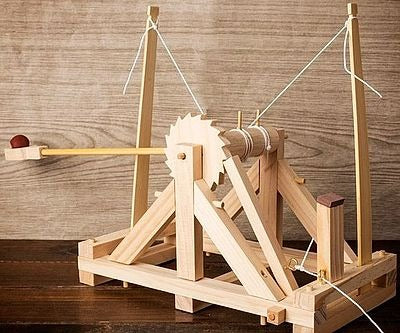
Leonardo Da Vinci Catapult
-
Introduction
- Introduce Leonardo da Vinci as a polymath and inventor
- Brief overview of his contributions to engineering and inventions
-
The Ingenious Mind of Leonardo
- Explore Leonardo's multifaceted talents and interests
- Discuss his curiosity-driven approach to innovation
-
Unveiling the Leonardo da Vinci Catapult
- Description of the catapult invention
- Explanation of its significance in military and engineering contexts
-
Leonardo's Pursuit of Engineering Marvels
- Discuss Leonardo's fascination with mechanics and engineering
- How his inventions bridged art, science, and technology
-
The Mechanics Behind the Catapult
- Explanation of the working principles of the catapult
- Discussion on the various components and their functions
-
Innovative Design and Functionality
- Explore how Leonardo's catapult design differed from traditional models
- The incorporation of precision and mechanical advantage
-
Military Applications and Strategy
- Discuss the historical context of warfare during Leonardo's time
- How the catapult and other inventions were intended for defensive purposes
-
Engineering Legacy and Influence
- How Leonardo's inventions influenced later generations of engineers
- The impact of his catapult design on the development of siege weaponry
-
Applying Modern Engineering Principles
- Analyze the catapult's design using modern engineering knowledge
- How the invention showcases Leonardo's advanced understanding of mechanics
-
Artistry in Engineering
- Explore the intersection of art and engineering in Leonardo's work
- How aesthetics played a role in his designs
-
Learning from Leonardo's Innovations
- Discuss the lessons that modern engineers can derive from Leonardo's approach
- The importance of curiosity, interdisciplinary thinking, and experimentation
-
The Catapult's Place in History
- How the catapult fits into Leonardo's broader legacy
- Reflect on the enduring fascination with his inventions
-
Beyond the Catapult: Other Leonardo Inventions
- Briefly touch on some of Leonardo's other notable inventions
- Highlight his contributions to various fields of study
-
Inspiring Creativity and Innovation
- How Leonardo's inventive spirit continues to inspire creativity today
- The relevance of his approach to problem-solving in contemporary times
-
Conclusion
Leonardo da Vinci Catapult: Bridging Art, Science, and Warfare

Introduction
Leonardo da Vinci, the quintessential Renaissance polymath, is celebrated for his artistic masterpieces and intellectual curiosity. However, his contributions extended far beyond the realm of art, encompassing engineering and innovation. Among his many inventions, the Leonardo da Vinci catapult stands as a testament to his ingenious mind and his ability to bridge the gap between art, science, and warfare.
The Ingenious Mind of Leonardo
Leonardo's legacy is built on his diverse talents—painting, sculpture, anatomy, and engineering. His curiosity knew no bounds, propelling him to explore the intricacies of nature, technology, and the human experience. This insatiable appetite for knowledge led him to create inventions that were both groundbreaking and visionary.
Unveiling the Leonardo da Vinci Catapult
One of Leonardo's most notable inventions is the catapult, a mechanical device with a rich history in siege warfare. This creation showcases not only his engineering prowess but also his deep understanding of mechanics and physics. The catapult's significance lies not only in its function but also in its representation of the intersection between artistry and innovation.
Leonardo's Pursuit of Engineering Marvels
Leonardo's fascination with mechanics was a driving force behind his inventions. He saw the world as an interconnected system of gears and levers, and his inventions aimed to harness these principles to solve practical problems. From machines to improve textile production to military weaponry like the catapult, Leonardo's work embodied his holistic approach to engineering.
The Mechanics Behind the Catapult
At its core, the catapult operates on the principle of stored potential energy. When the tension created by winding the mechanism is released, it converts potential energy into kinetic energy, propelling the projectile forward. Leonardo's design incorporated a tensioning system and a sophisticated release mechanism to achieve maximum efficiency.
Innovative Design and Functionality
Leonardo's catapult design departed from traditional models of his time. He introduced innovations in the mechanical advantage and the control of projectile trajectory. These modifications improved accuracy and power, showcasing his meticulous attention to detail and his commitment to refining existing technologies.
Military Applications and Strategy
During the era of Leonardo, siege warfare was a common aspect of military strategy. The catapult played a vital role in breaching fortified structures, and its invention demonstrated Leonardo's understanding of military tactics. His intention was not only to create effective weaponry but also to offer defensive solutions for cities under siege.
Engineering Legacy and Influence
Leonardo's catapult design was emblematic of his broader influence on engineering. His inventions inspired generations of engineers, and his innovative thinking set the stage for future technological advancements. The principles he established continue to resonate in contemporary engineering practices.
Applying Modern Engineering Principles
When scrutinized through the lens of modern engineering knowledge, Leonardo's catapult design remains impressive. His comprehension of mechanics and physics allowed him to create a functional and efficient device. This understanding speaks to his mastery of foundational engineering principles.
Artistry in Engineering
Leonardo's artistic sensibilities played a significant role in his engineering work. His ability to blend aesthetics with functionality was a hallmark of his designs. The catapult, while primarily a tool of war, exhibited an elegance and precision that set it apart from its predecessors.
Learning from Leonardo's Innovations
Modern engineers can glean valuable lessons from Leonardo's inventive approach. His willingness to question conventions, his interdisciplinary thinking, and his dedication to experimentation are all qualities that continue to define successful engineers today.
The Catapult's Place in History
While the Leonardo da Vinci catapult is but one of his many inventions, it remains a captivating symbol of his ingenuity. It provides a glimpse into a period when art, science, and technology were interconnected realms of human achievement.
Beyond the Catapult: Other Leonardo Inventions
Leonardo's inventive spirit extended far beyond the catapult. His notebooks are filled with sketches and ideas ranging from flying machines to anatomical studies. This versatility highlights his ceaseless curiosity and his desire to comprehend the world around him.
Inspiring Creativity and Innovation
Leonardo's legacy lives on in the hearts of those who dare to think differently. His inventive spirit inspires creativity and innovation, reminding us that the pursuit of knowledge knows no boundaries.
In conclusion, the Leonardo da Vinci catapult stands as a remarkable example of the synthesis of art and engineering. In an age where boundaries between disciplines were fluid, Leonardo exemplified the concept of the polymath, creating inventions that continue to captivate and inspire. The catapult's engineering marvel reflects not only the mechanics of warfare but also the boundless potential of human imagination.
Frequently Asked Questions
-
What is the Leonardo da Vinci catapult? The Leonardo da Vinci catapult is an invention designed by Leonardo da Vinci, featuring an innovative mechanism for launching projectiles.
-
What was the purpose of the catapult? Catapults were historically used in warfare for besieging fortified structures. Leonardo's catapult aimed to improve accuracy and power in this context.
-
How does Leonardo's catapult differ from earlier designs? Leonardo's catapult introduced advancements in mechanical advantage and trajectory control, enhancing accuracy and efficiency.
-
What is the legacy of Leonardo da Vinci's inventions? Leonardo's inventions, including the catapult, have inspired generations of engineers and continue to symbolize innovation and interdisciplinary thinking.
-
How did Leonardo's artistic skills influence his engineering work? Leonardo's artistic sensibilities informed his engineering designs, resulting in inventions that blended functionality with aesthetics.
